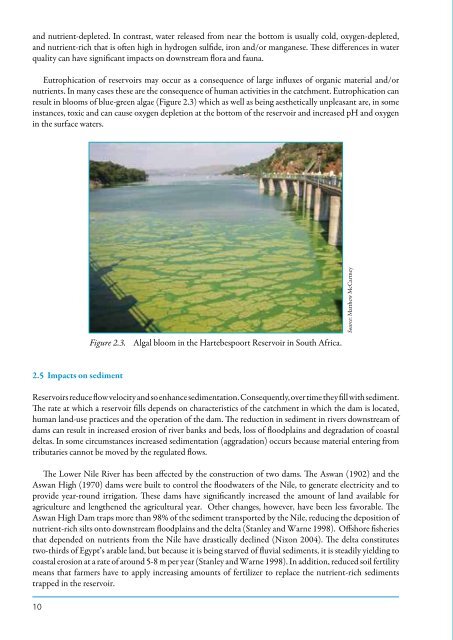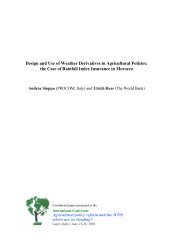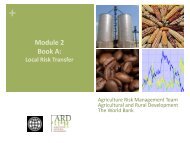Use of decision support systems to improve dam planning and dam ...
Use of decision support systems to improve dam planning and dam ...
Use of decision support systems to improve dam planning and dam ...
Create successful ePaper yourself
Turn your PDF publications into a flip-book with our unique Google optimized e-Paper software.
<strong>and</strong> nutrient-depleted. In contrast, water released from near the bot<strong>to</strong>m is usually cold, oxygen-depleted,<br />
<strong>and</strong> nutrient-rich that is <strong>of</strong>ten high in hydrogen sulfide, iron <strong>and</strong>/or manganese. These differences in water<br />
quality can have significant impacts on downstream flora <strong>and</strong> fauna.<br />
Eutrophication <strong>of</strong> reservoirs may occur as a consequence <strong>of</strong> large influxes <strong>of</strong> organic material <strong>and</strong>/or<br />
nutrients. In many cases these are the consequence <strong>of</strong> human activities in the catchment. Eutrophication can<br />
result in blooms <strong>of</strong> blue-green algae (Figure 2.3) which as well as being aesthetically unpleasant are, in some<br />
instances, <strong>to</strong>xic <strong>and</strong> can cause oxygen depletion at the bot<strong>to</strong>m <strong>of</strong> the reservoir <strong>and</strong> increased pH <strong>and</strong> oxygen<br />
in the surface waters.<br />
2.5 Impacts on sediment<br />
10<br />
Figure 2.3. Algal bloom in the Hartebespoort Reservoir in South Africa.<br />
Reservoirs reduce flow velocity <strong>and</strong> so enhance sedimentation. Consequently, over time they fill with sediment.<br />
The rate at which a reservoir fills depends on characteristics <strong>of</strong> the catchment in which the <strong>dam</strong> is located,<br />
human l<strong>and</strong>-use practices <strong>and</strong> the operation <strong>of</strong> the <strong>dam</strong>. The reduction in sediment in rivers downstream <strong>of</strong><br />
<strong>dam</strong>s can result in increased erosion <strong>of</strong> river banks <strong>and</strong> beds, loss <strong>of</strong> floodplains <strong>and</strong> degradation <strong>of</strong> coastal<br />
deltas. In some circumstances increased sedimentation (aggradation) occurs because material entering from<br />
tributaries cannot be moved by the regulated flows.<br />
The Lower Nile River has been affected by the construction <strong>of</strong> two <strong>dam</strong>s. The Aswan (1902) <strong>and</strong> the<br />
Aswan High (1970) <strong>dam</strong>s were built <strong>to</strong> control the floodwaters <strong>of</strong> the Nile, <strong>to</strong> generate electricity <strong>and</strong> <strong>to</strong><br />
provide year-round irrigation. These <strong>dam</strong>s have significantly increased the amount <strong>of</strong> l<strong>and</strong> available for<br />
agriculture <strong>and</strong> lengthened the agricultural year. Other changes, however, have been less favorable. The<br />
Aswan High Dam traps more than 98% <strong>of</strong> the sediment transported by the Nile, reducing the deposition <strong>of</strong><br />
nutrient-rich silts on<strong>to</strong> downstream floodplains <strong>and</strong> the delta (Stanley <strong>and</strong> Warne 1998). Offshore fisheries<br />
that depended on nutrients from the Nile have drastically declined (Nixon 2004). The delta constitutes<br />
two-thirds <strong>of</strong> Egypt’s arable l<strong>and</strong>, but because it is being starved <strong>of</strong> fluvial sediments, it is steadily yielding <strong>to</strong><br />
coastal erosion at a rate <strong>of</strong> around 5-8 m per year (Stanley <strong>and</strong> Warne 1998). In addition, reduced soil fertility<br />
means that farmers have <strong>to</strong> apply increasing amounts <strong>of</strong> fertilizer <strong>to</strong> replace the nutrient-rich sediments<br />
trapped in the reservoir.<br />
Source: Matthew McCartney





